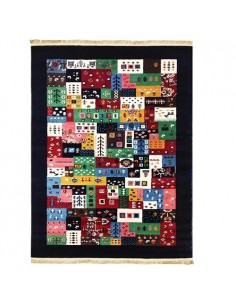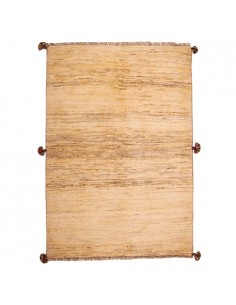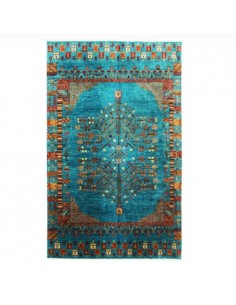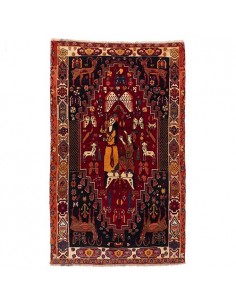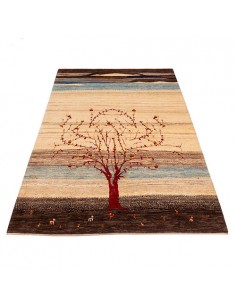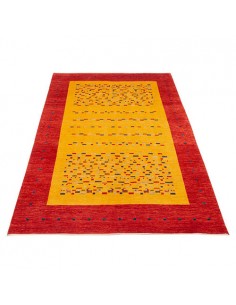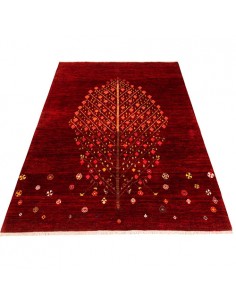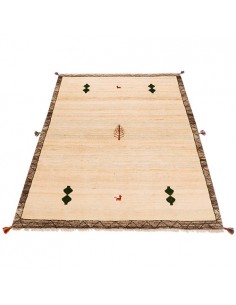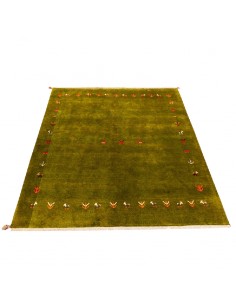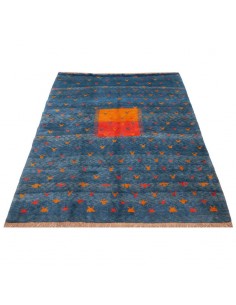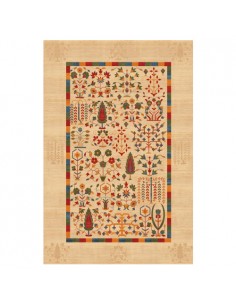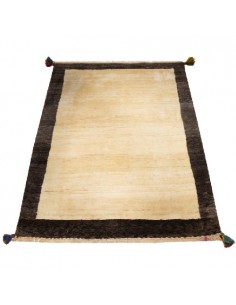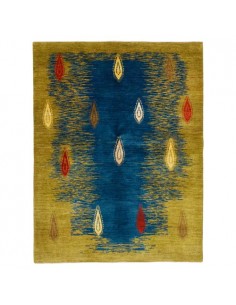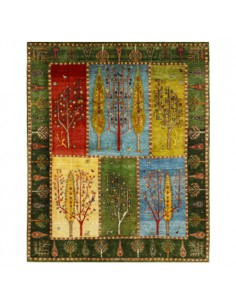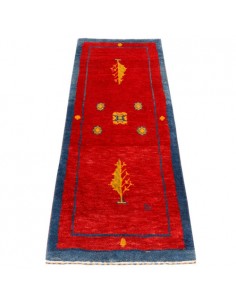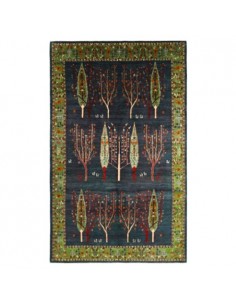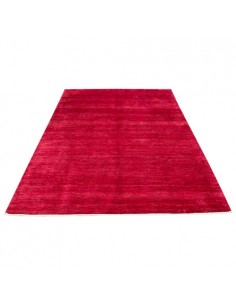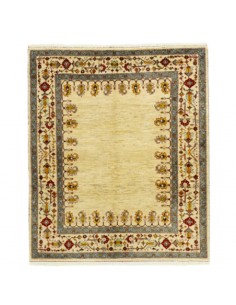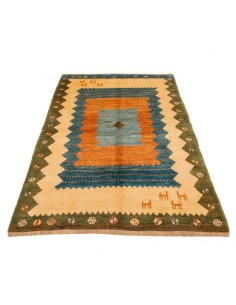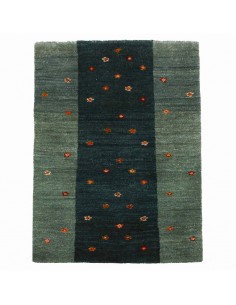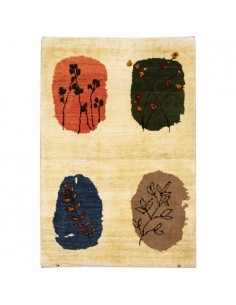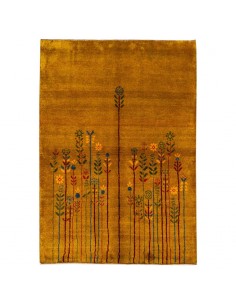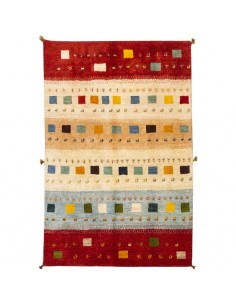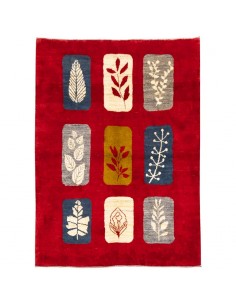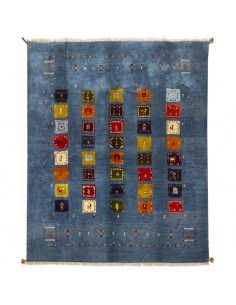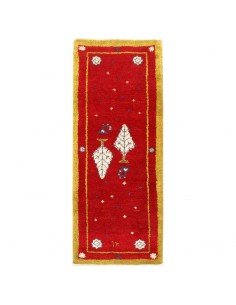Gabbeh Rugs
Gabbeh rugs are among the few original Iranian rugs that have been popular in many villages since ancient times, especially among the nomads. Today, rugs are one of the most important elements in interior decoration and play an important role in revitalizing the interior of the building.
Gabbeh Rug Review, Select, and Buying Guide
Like other Persian rugs, Gabbeh rugs have beautiful designs and special patterns you will not find anywhere else!
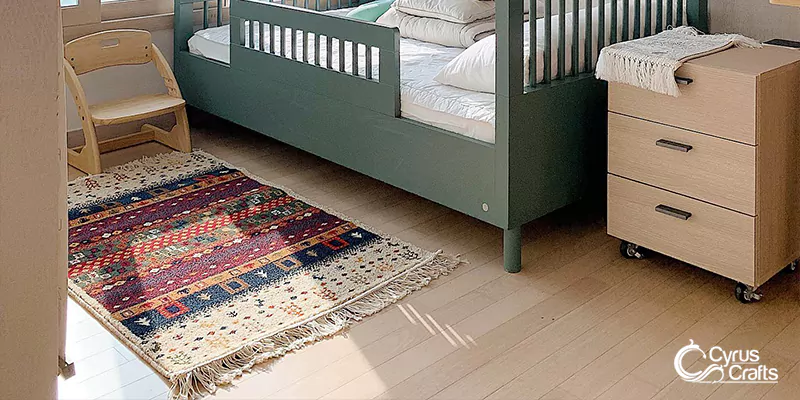
Cyrus Crafts; Luxury & Unique Products
Depending on the type of texture, yarn, and designs, Iranian rugs, including silk rugs, wall rugs, kilims, carpets, area rugs, and "Gabbeh rugs," have a lot of variety. This article explains the features, weaving methods, types of designs, and colors used in the Gabbeh rugs.
Gabbeh Rugs Features
To be able to give you more information about the Gabbeh rugs, it is better to pay attention to their features, including the type of texture and designs. These vintage rugs are often known as a type of handmade rugs because, in the past, nomadic women wove Gabbeh rugs with their hands and on horizontal carpet looms (looms lying on the ground) and also without a plan and just by using the mind and creativity of the weaver. Still, today, this kind of rug is produced in various designs manually and by machine, giving you more options.
Suppose you are planning to buy a Gabbeh rug. In that case, you should know that the number of reeds and density greatly impacts the life and quality of the rug because carpets with higher density have a finer texture and greater durability.
However, Gabbeh handmade rugs are woven in the form of knots with long piles, the piles of which are usually one to three centimeters long. In the past, Gabbeh rugs were woven only for personal use, but now, this beautiful rug has found many fans in Iran and worldwide. For this reason, the production and export of Gabbeh rugs have made those interested in this art more familiar with Persian art and culture.
Gabbeh rugs are usually woven in the "Persian" style, but the nomads have also used the "Turkish" style. The spring wool, spun by hand and dyed with plant and natural methods, is used to weave high-quality Gabbeh rugs.
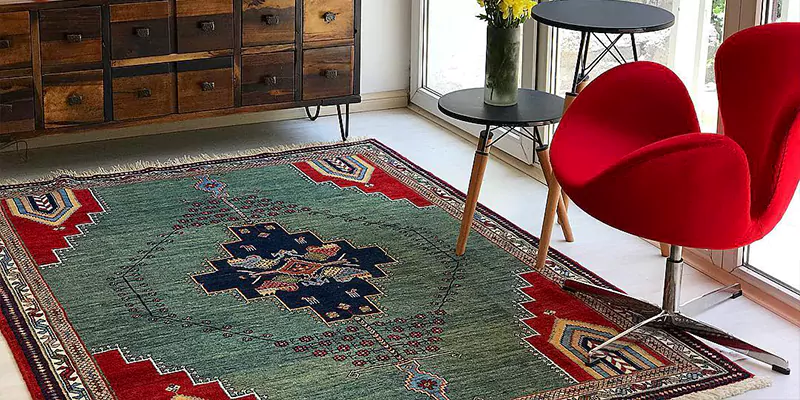
Types of Gabbeh Rugs
Sometimes, there is no pre-determined pattern or motif for Gabbeh weaving, and the weavers weave Gabbeh according to their spirits, taste, and creativity, or their surroundings inspire them. It can be said that weavers leave a part of their soul in their work. With this idea, you can better understand Gabbeh's artistic and historical value and realize that this is not just a rug to cover the ground.
The most famous Gabbeh rugs belong to the Qashqai tribes of Iran, the most important motifs of which are:
- Gabbeh rugs with motifs of brick
- Gabbeh rugs with motifs of flower
- Gabbeh rugs with motifs of lion
- Gabbeh rugs with motifs of flower
- Gabbeh rugs with motifs of Pond
- Gabbeh rugs with motifs of tree
- Gabbeh rugs with tribal motifs
- Gabbeh rugs with brindled motifs
- Gabbeh rugs with geometric motifs
- Gabbeh rugs with four-season motifs
- Gabbeh rugs with motifs of duck
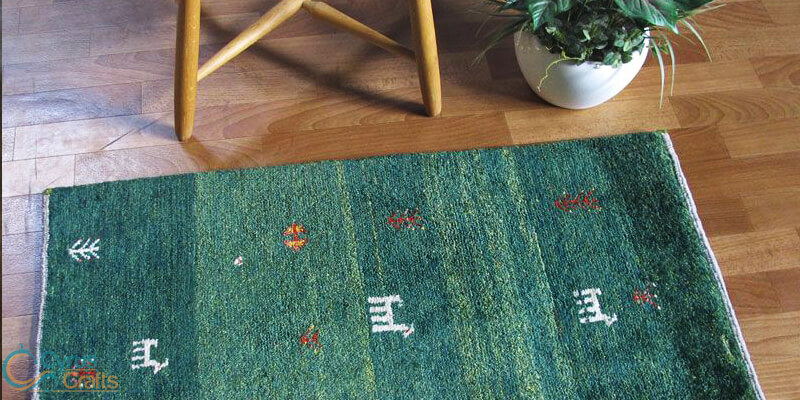
Gabbeh Rugs with Motifs of Brick (Frame-Shape)
In this type of Gabbeh rug, a rectangular frame is placed in the middle, and different motifs in small sizes are regularly placed inside it, which can be said to have a tile-like motif. Inside each tile or frame are woven motifs such as flowers, trees, animals, birds, etc.; some frames are decorative star motifs.
Some Gabbeh rugs are also woven with a black and white checkered pattern, symbolically representing the days of nomadic weavers. The white and black parts represent good and bad days, respectively. For this reason, it sometimes happened that several black squares or several white squares were located next to each other.
Gabbeh Rugs with Motifs of a Lion
The lion motif on the Gabbeh rugs is one of the most popular motifs among the tribes and nomads of southwestern Iran. The lion motif has always had a special place in Persian culture.
The lion symbolizes strength, courage, and sobriety among Iranians and has a special place in Iranian culture. As mentioned, weavers were inspired by the nature around them to weave Gabbeh rugs. It should be noted that in the past, many lions lived in the Fars province of Iran, which has become extinct over time. For this reason, the motif of the lion is often seen in the texture of the Gabbeh rugs woven in these areas.
Gabbeh Rugs with Motifs of Flowers
Sometimes, the motif of a rose is used in the texture of Gabbeh rugs. This type of Gabbeh rug is also called Gabbeh with a floral motif. In the rug's background are flowers of different colors and green leaves; other patterns are woven in the margins. Usually, the color of the flowers in the background of a Gabbeh rug differs from the color used in the margins (borders).
Gabbeh Rugs with Motifs of a Pool
As far as the motifs of the pool in a Gabbeh rug are concerned, a medallion with a flower motif is placed in the middle of the rug, and beautiful buds, leaves, and flowers are woven around it. The medallion in the middle Gabbeh rug is sometimes called a pool because the pool was located in the middle of the yard in old houses. This theme has inspired the pool motif used in the Gabbeh rugs.
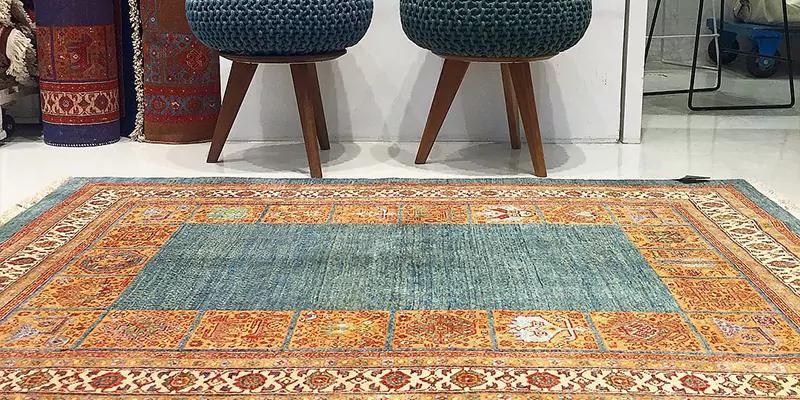
Gabbeh Rugs with Rribal Motifs
This motif is also one of the widely used motifs in Gabbeh weaving. The tribal motifs have no special role and are woven improvisationally. Gabbeh rugs with tribal motifs usually have a frame with a geometric shape such as square, rectangle, circle, oval, or rhombus, each of which is decorated with motifs from nature such as flowers, plants, and trees, and weavers choose the color of each based on their taste.
Gabbeh Rugs with Brindled Motifs
The term "brindled motif" refers to colorful jewelry used to adorn and beautify horses, but in Gabbeh weaving, the term is used to create a light shade in the design using streaked colored threads. The brindled motif is inspired by barley and wheat fields as the wind blows through their clusters. Brindled motifs are usually used for backgrounds or borders.
Gabbeh Rugs with Geometric Motifs
As its name suggests, this motif has a simple appearance and uses geometric shapes such as triangles, rhombuses, squares, ovals, etc. Geometric motifs have different types, such as frame layout, Joshghani, Khatam Shiraz, star, and Khatai motifs.
Gabbeh Rugs with Four-Season Motifs
The name of this type of Gabbeh signifies the motifs used in it. Different scenes of each season can be seen on these Gabbeh rugs.
Gabbeh Rugs with motifs of a Tree
The tree was another symbol or motif used by nomads and villagers in weaving Gabbeh rugs. Like other natural elements, trees have existed since the beginning of human creation and have played a major role in human life. Motifs of weeping willow and cypress trees are often seen in the texture of Gabbeh rugs. The cypress tree is a symbol of joy and happiness, and the weeping willow is a symbol of sorrow and grief.
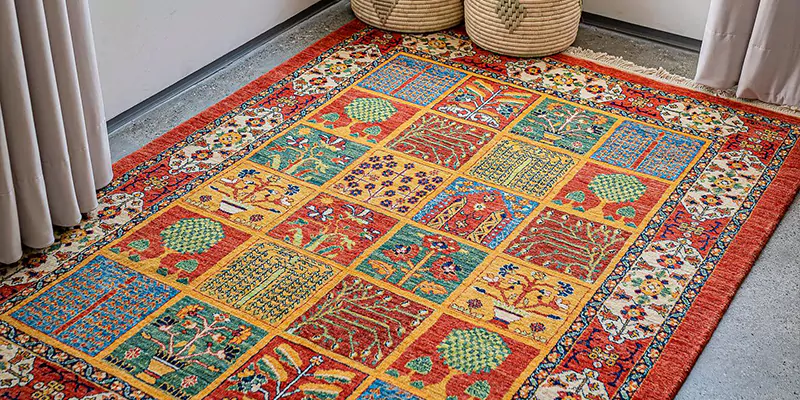
Gabbeh Rugs with Motifs of a Duck
This motif belongs to one of the Qashqai tribes, Shorkhani, who often spend the summer around Abadeh. In this type of Gabbeh, the shapes are placed symmetrically and repetitively in a row and cover the entire background.
Price of Persian Gabbeh Rugs
Gabbeh rugs are divided into two categories:
- Machine-woven Gabbeh rugs
- Handmade Persian Gabbeh rugs, usually woven by nomads with imaginary designs.
Machine-knotted ones have an acceptable quality, but due to the natural and non-chemical dyeing, artistic value, and high quality of Hand-knotted Gabbeh rugs, they can have higher prices than machine-knotted ones.
At Cyruscrafts, you can buy premium Gabbeh rugs at the best prices. Gabbeh rug's price depends on the quality, type of texture, weaving technique, dyeing, ETC. It can approximately vary from $40 to $1270.
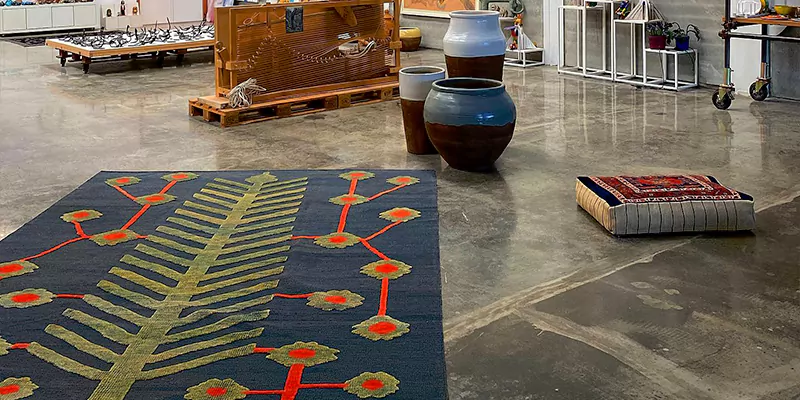
Colors Used in the Persian Gabbeh Rugs
Initially, the wool of sheep, goats, camels, etc., was used in weaving Gabbeh with the same natural color as the wool, usually cream, brown, black, or white. But over time, with the migration of nomads and their familiarity with various natural colors, as well as how to use them to dye wool, Gabbeh weaving with various colors gradually became more common.
This combination of colors in Gabbeh rugs reflects the spirits of the nomads because the colors are taken from nature and the plants in which they live.
For example, red, warm and extroverted color in Gabbeh weaving, symbolizes activity, ability, strengthening of the heart, struggle, truth, and martyrdom and inspires excitement in the viewer.
The yellow color, known as the color of youth, light, and brightness, is joyful, a sign of knowledge, and is very important among the tribes.
The white carpet is a symbol of brightness and freshness. In the case of Gabbeh rugs, white is one of the most common and widely used colors because the wool of many sheep is white or milky.
Purple is also used to mean ignorance, difficulty, and cruelty and is said to be a mysterious color that evokes emotions, sometimes even instilling fear in the viewer.
Gabbeh Rugs Maintenance
As much as the initial stages of Gebbeh rug production have their importance, its maintenance also requires care and attention, which increases the durability of Gabbeh rugs. The factors that damage all Gabbeh rugs include insects such as willows, termites, cockroaches, and mice, the worst of which is willow.
Prevention Gabbeh Rugs to Willow
Spray the back and top of the Gabbeh Rug with insecticide and use a chemical solution when washing. But if you are going to keep the gabe and not use it, be sure to put tobacco and naphthalene between them so that there is no opportunity for willow to grow.
Protect Against Sunlight
It doesn't matter what you have, whether machine-made or hand-woven Gabbeh Rugs; in any case, you should not expose it to direct sunlight for a long time because it causes the color to fade, especially if the color is not natural and chemical dyes are used.
Also, avoid putting it in a dark and humid environment because it causes decay and the growth of insects.
Gabbeh Rug Cleaning
Clean and sweep the rug in a short period of time, because if a long period passes and the dust reaches the root of the Gabbeh and stays there and is not cleaned, it will cause your rug to harden and break.
If you want to wash your Gabbeh rug, it is better to sweep it before washing it and then use a shampoo.
Necessary Tips When Buying Gabbeh Rugs
If you are interested in the Gabbeh rug, you should consider some essential points when buying it. If you are planning to buy a hand-woven Gabbeh, you should pay attention to the fact that they require more special care due to their price, and try to spread that in places in the house where it gets less dirty and does not require a lot of washing.
If you are going to buy a machine-made Gabbeh rug, pay attention to the fact that the carpet you buy is made of high-quality fibers. Also, try to choose a Gabbeh that has more natural colored fibers in its texture and less chemically colored fibers.
Gabbeh Rug Color when buying
As we told another point that you should pay attention to when buying a Gabbeh rug is to distinguish whether the color of the rug is natural, artificial, or chemical because it is effective in increasing its life span. You can understand by looking at the carpet! How're you?
Test whether its color is natural or artificial; has the color been injected into ink, or have they used colored threads for its texture?
The Method of Detecting the Color of the Gabbeh Rug
If the color of the Gabbeh is sharp, it is a chemical dye. And if the background color is soft and draws less attention, the fibers are natural.
You can use a tissue and draw it on the carpet; if the tissue is colored, it means that it is an artificial color; if it is not, it means that a natural color has been used in the product.
Cyruscrafts Gabbeh Rugs
In this article, we tried to cover all the important facts about Gabbeh rugs and their different types to familiarize you with the original Iranian culture and its special arts, which have a long history.
You must know that Persian carpets have been produced, supplied, and exported for many years. Still, we hope that considering the capabilities and knowledge available in the CyrusCrafts collection, they will take a greater share in the global markets.
CyrusCrafts collection, with specialized activity in the field of preparing, selling, and exporting the best samples of Gabbeh rugs, provides you with high quality and inimitable products to The Middle East, Canada, the USA, and Europe so that you can experience a wonderful and unique feeling in the decoration of your home or workplace.


